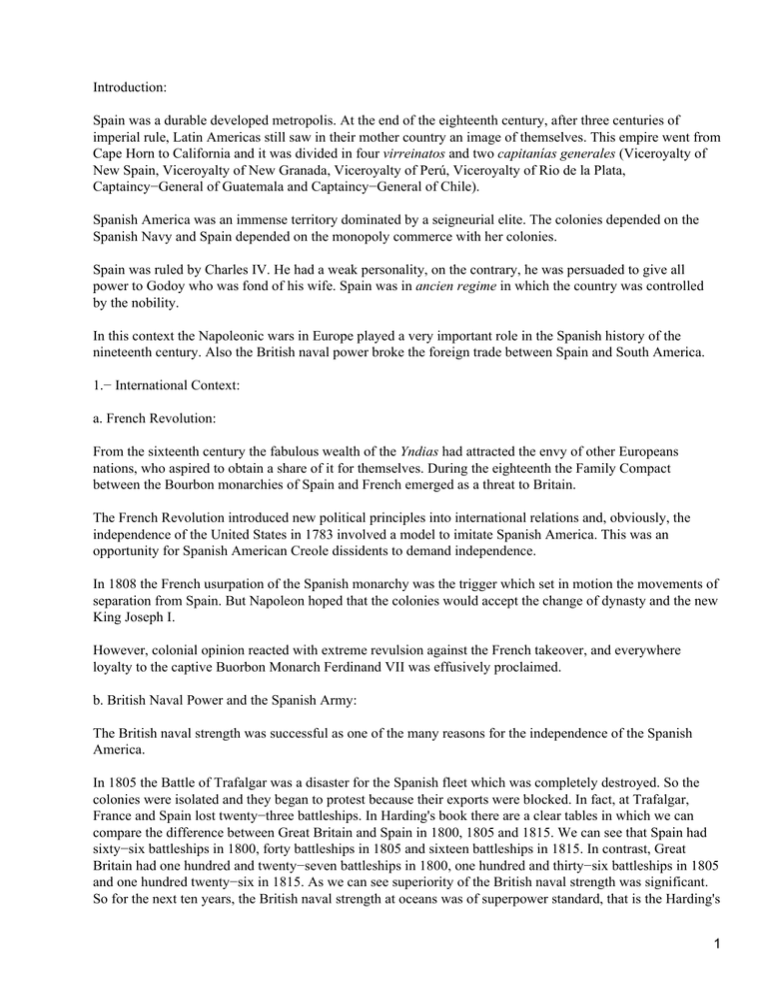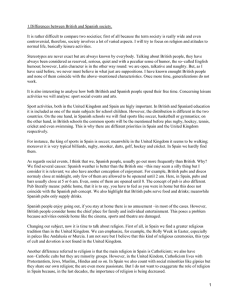Introduction: Spain was a durable developed metropolis. At the end of...
Anuncio

Introduction: Spain was a durable developed metropolis. At the end of the eighteenth century, after three centuries of imperial rule, Latin Americas still saw in their mother country an image of themselves. This empire went from Cape Horn to California and it was divided in four virreinatos and two capitanías generales (Viceroyalty of New Spain, Viceroyalty of New Granada, Viceroyalty of Perú, Viceroyalty of Rio de la Plata, Captaincy−General of Guatemala and Captaincy−General of Chile). Spanish America was an immense territory dominated by a seigneurial elite. The colonies depended on the Spanish Navy and Spain depended on the monopoly commerce with her colonies. Spain was ruled by Charles IV. He had a weak personality, on the contrary, he was persuaded to give all power to Godoy who was fond of his wife. Spain was in ancien regime in which the country was controlled by the nobility. In this context the Napoleonic wars in Europe played a very important role in the Spanish history of the nineteenth century. Also the British naval power broke the foreign trade between Spain and South America. 1.− International Context: a. French Revolution: From the sixteenth century the fabulous wealth of the Yndias had attracted the envy of other Europeans nations, who aspired to obtain a share of it for themselves. During the eighteenth the Family Compact between the Bourbon monarchies of Spain and French emerged as a threat to Britain. The French Revolution introduced new political principles into international relations and, obviously, the independence of the United States in 1783 involved a model to imitate Spanish America. This was an opportunity for Spanish American Creole dissidents to demand independence. In 1808 the French usurpation of the Spanish monarchy was the trigger which set in motion the movements of separation from Spain. But Napoleon hoped that the colonies would accept the change of dynasty and the new King Joseph I. However, colonial opinion reacted with extreme revulsion against the French takeover, and everywhere loyalty to the captive Buorbon Monarch Ferdinand VII was effusively proclaimed. b. British Naval Power and the Spanish Army: The British naval strength was successful as one of the many reasons for the independence of the Spanish America. In 1805 the Battle of Trafalgar was a disaster for the Spanish fleet which was completely destroyed. So the colonies were isolated and they began to protest because their exports were blocked. In fact, at Trafalgar, France and Spain lost twenty−three battleships. In Harding's book there are a clear tables in which we can compare the difference between Great Britain and Spain in 1800, 1805 and 1815. We can see that Spain had sixty−six battleships in 1800, forty battleships in 1805 and sixteen battleships in 1815. In contrast, Great Britain had one hundred and twenty−seven battleships in 1800, one hundred and thirty−six battleships in 1805 and one hundred twenty−six in 1815. As we can see superiority of the British naval strength was significant. So for the next ten years, the British naval strength at oceans was of superpower standard, that is the Harding's 1 conclusion: When the Napoleonic wars ended in 1815, Britain was the only global maritime power. [..] The only other naval power whose capability showed a marked increase in the years following 1815 was the United States. In addition, to having suffered a grave setback in Trafalgar Cape, Spain was occupied by the French army, and the Spanish army was unable to defence its territory. In fact, British troops and the Duke of Wellington helped Spain. This is an example of weakness in Spanish army, so the Spanish imperial power become seriously in doubt. 2.− Internal Situation: a. Political: This period is known as the crisis of the ancien regime. It dates back to 1808 and the death of Ferdinand VII in 1833 and involves the change to the liberal regime. During those twenty−five years Spain suffered the War of Independence (1808−1813) in her territory and two armies revolts in 1820 and 1823. Therefore we can think that it was a chaotic situation. If we compare Spain with Britain: in Britain the power of the crown and aristocracy had been challenged and severely reduced in the seventeenth century, freeing Parliament and the middle class to aspire to both political and economic success. In Spain, the dead hand of a near feudal ancien regime continued without reform and suffocated the evolution of all forms of change and modernity. It was an inflexible, hierarchical society, dominated by the nobility who sought only to maintain a traditional rural structure, which was organised to provide large numbers for military service rather than to facilitate increases in production and efficiency. The crisis of the acien regime started with the French invasion in 1808. Napoleon's troops occupied the country. Napoleon was determined to convert Spain into a satellite state and to manage its resources. Neither the Council of Castile nor the Junta of Government could be expected to lead a hopeless revolt against French garrisons by disobeying Ferdinand's explicit orders. Irritated by the exactions of French intentions, the Council, nevertheless, co−operated with Murat, the commander of the French army of occupation. At the same time Ferdinand VII abdicated in favour of Joseph I (Napoleon's brother). On this premise it is not difficult to imagine that the Spanish American colonies took advantage and did not recognise the new King Joseph I. Finally, the French army withdrew to France and Ferdinand VII returned to Madrid in 1814. But six years later there was a liberal army revolt and the monarch was forced to accept the constitution of 1812. Due to the liberal army revolt, the American policy of Spanish government returned the confusions of the Cortes of Cadiz: they could neither continue despotism nor evolve a policy to reconcile liberal Spain and her revolved colonies. It is likely that Americans would see the new policy as being better than despotism. Meanwhile, the Holy Alliance was thinking about the possibility of sending and army of occupation to Spain to restore the absolutism. So in 1823 the Hundred Thousand Sons of St. Louis crossed the frontier and the Spanish generals in an attempt to secure their position, by negotiating a compromise settlement. To sum up, we can see that the chaotic political situation could affect the independence of the Americans colonies. b. Economy: The loss of the Spanish fleet at the Battle of Trafalgar and the unstable internal political situation were two important events, which destroyed the Spanish economy. The Battle of Trafalgar was terrible for market between Spain and her colonies. At that time a trip to Yndias was dangerous and very long so it was necessary 2 to gain protection at all times. So the Spanish fleet was temporally eliminated from the Atlantic Ocean, and due to British naval power, Spanish commerce with Latin America was completely paralysed. Moreover, the Spanish merchants were replaced by British ones who gained control of the Atlantic Ocean. Moreover, the Spanish naval construction was in a very difficult situation; only after 1827 do we find examples of recovery in some shipyards and dockyards. However, before the Battle of Trafalgar, Spain had an economic policy that put restrictions on the modernisation of agriculture, so too it retarded manufacturing enterprise. Choice sector industries were reserved by the government for the grant monopoly rights. These grants were distributed according to the political influence of their recipients, rather than their business acumen. That policy included American trade and obtained good incomes during the sixteenth, seventeenth and eighteenth centuries. However, for seven years after the Peace of Amiens (1802), Spanish shipping, confined in the Mediterranean, disappeared from Atlantic Ocean. The most important port in American trade was Cadiz and during these years it suffered great losses. On the other hand, American ports were not closed, instead they were allowed to trade with neutral countries because of a Crown Decree (1797). This is because a few conditions which were not observed. This was the beginning of the end of monopoly trade with Spanish America. As Vicens Vives said: the decree of 1797 concerning permission to trade with neutral ships was prelude to the Spanish−American colonies independence. We can say that the main problem of the Spanish economy was the integration. In other words, Spain had to develop its internal communications systems, permitting an increasing exchange of goods. Because, the Spanish economy depended too much on the trade with Latin America. Conclusion: To finish this essay a global perspective is necessary. We should remember the significance of geography. At that time, they did not have a good postal service they had to wait for six months to receive a letter so, it is obvious, they did not have telephone, electronic mail The fastest transport was navigation. This is logical but is one of the most important things to allow us understand the context. Because, when Spain decided to send a big army to over power the Spanish American armies, it was too late to create a well trained army which could defeat the enemy. In addition, Spain was unstable country because it was ruled by unstable King (Ferdinand VII) who did not have a good personality. We have to remember that Ferdinand was convinced by Napoleon to abdicate and four years later he wanted to return to the Spanish throne. At the beginning of the independence process, Spain had suffered a war, political disorder and disturbances so people were confused. Moreover, the economy was a disaster and it could not support the creation of a new army to sending it to America. Another important question is the British naval power at the beginning of nineteenth century. In fact, some historians said that the supremacy of the British navy was the most important role in the independence of Latin America. Finally, American colonies social situation brought about the fall of Spanish Empire, because only a minority supported the Spanish government. On the contrary, most of people trust on libertadores San Martín and Bolivar. They became national heroes. We can conclude that the answer to the main question: Why was Spain unable to defeat the Spanish−American movements for independence? It is a complex question. On the contrary, there are multiple 3 roles. The problem is that all the roles happened at the same time and Spain could not control the situation. Bibliography: CARR, R.: Spain 1808−1939, Oxford University Press, 1966. HARDING, R.: Seapower and Naval Warfare 1650−1830, University College London Press, 1999. KINTH: The convulsion of Europe: The Naval Conflict during the revolutionary and Napoleonic Wars, in Maritime History: The Eighteenth century and the Classic Age of Sail, Krieger Publishing Company, 1997. LYNCH, J.: The Spanish American revolutions, 1808−1826, Weindelfeld and Nicolson, 1973. LYNCH, J.: The origins of Spanish American Independence, in The Cambridge History of Latin America, Cambridge University Press, 1985. VICENS VIVES, J.: An Economic History of Spain, Princeton University Press, 1969. WADELL: International politics and Latin American Independence, in The Cambridge History of Latin America, Cambridge University Press, 1985. HARDING, R.: Seapower and Naval Warfare 1650−1830, University College London Press, 1999. P. 292−294, Tables A3 and A4. There are another interesting table in page 270, Table 10.1 The balance of naval forces, 1790−1805. HARDING, R.: Seapower and Naval Warfare 1650−1830, University College London Press, 1999. P. 277−278. View section: Political CARR, R.: Spain 1808−1939, Oxford University Press, 1966. CARR, R.: Spain 1808−1939, Oxford University Press, 1966. P. 143. VICENS VIVES, J.: An Economic History of Spain, Princeton University Press, 1969. P. 580. 1 4 4
